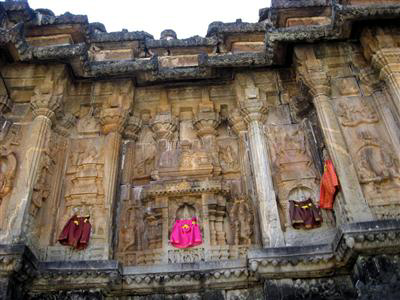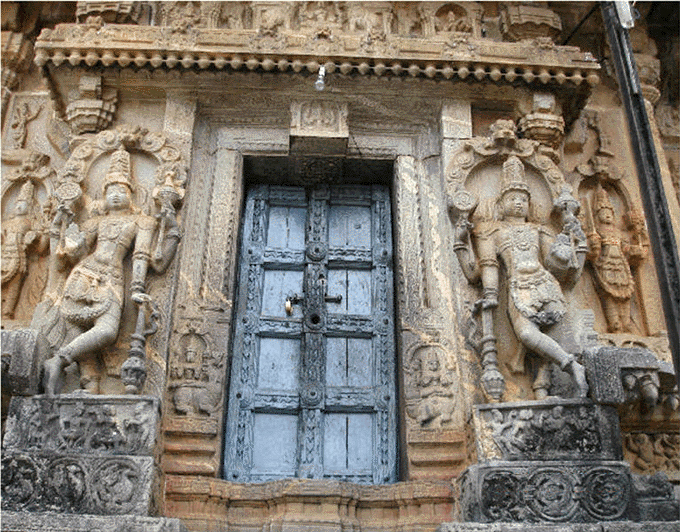
|
|
|
|
Vidyashankara Temple is located on the pinnacle of the Sahayadri Hills in the Chikmanglur district of Karnataka, beside the Tungabhadra River. The temple stands on a plinth, with an excellent view from the hills. It faces the east, and has a mandapa (hall) in front of the sanctum, with three entrances: to the east, south, and north.
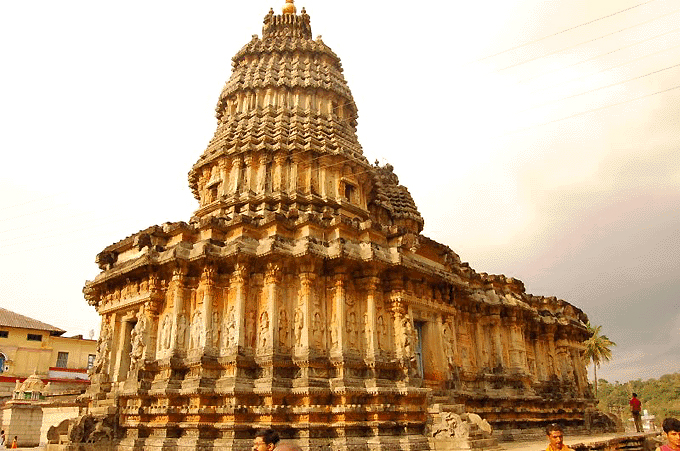
Vidyashankara Temple A pradakshina (passageway) circumambulates around the sanctum. There is also a navaranga, or central hall, about 18 feet in height. At the center, on the ceiling, is a beautiful panel of concentric squares ornamented with lotus buds and petals, with pecking parrots on the side. On the floor below is a large circle, marked with converging lines to indicate the path of the sun's moving rays.
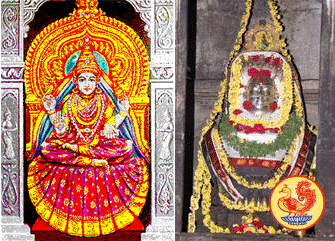
Saraswati Devi and Sri Vidyashankara The presiding deity here is Sri Vidyashankara himself, in lingam form. Inside the temple, facing the sanctum sanctorum are three niches for the subsidiary deities, which include Brahma and Saraswati on the south, Laksmi-Narayana on the west, and Uma-Mahesvara on the north. Unfortunately the temple strictly prohibits photographing the deities.
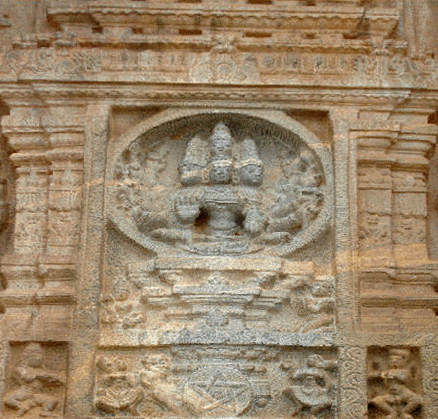
Exterior Panel The temple's exterior is richly carved with many different divine personalities. Between the eastern and southern entrances are murtis of Indra, Yama with two dogs, along with Sri Rama, the Sage Vyasa, Durga and Sani (Saturn). Near the southern entrance to the pradakshina is another panel with Brahma and Saraswati along with Laksmi-Narayana, Hanuman, and Garuda. Between the southern and western entrances are Kalki on his horse holding a sword, with Venugopala, Balarama, and Parasurama. Between the western and northern entrances are Vamana and Bali, Kurma, Matsya, Harihara, and Markandeya embracing the linga while being dragged by Yama and his noose. There is also Ardhararisvara, Tiruparasamhara and Manmatha (Cupid), aiming his arrows at Shiva. Between the pradakshina and the northern entrance are Saraswati Devi, Candra, Hayagriva, and Annapurna with pot and ladle.
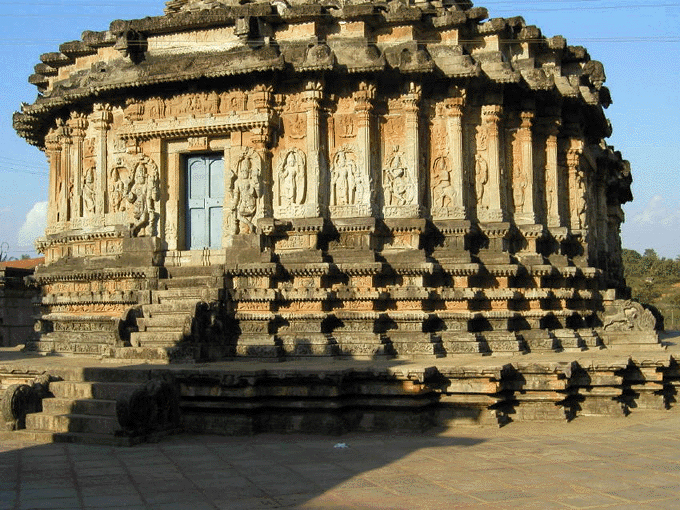
Vidyashankara Temple exterior carvings Near the front entrance is a murti of Vyasa with a palm leaf manuscript in his hand, instructing Shankaracarya. There are many ornamental animals and figures, and an amazing set of stone chains hanging from the hall corners. There is a 12-pillared Navagraha hall, the pillars ornamented with riders on lions. The lions have stone balls in their mouths that can be freely rolled around, but not removed, demonstrating the excellence of the carvers. Each of the pillars, known as Rashistambhas, bear a symbol of the Zodiac, and they are placed in such a way that in the order of the solar months, the sun's rays fall on one pillar after another, in proper order. The Navagraha personalities and Lord Surya are featured on the ceiling.
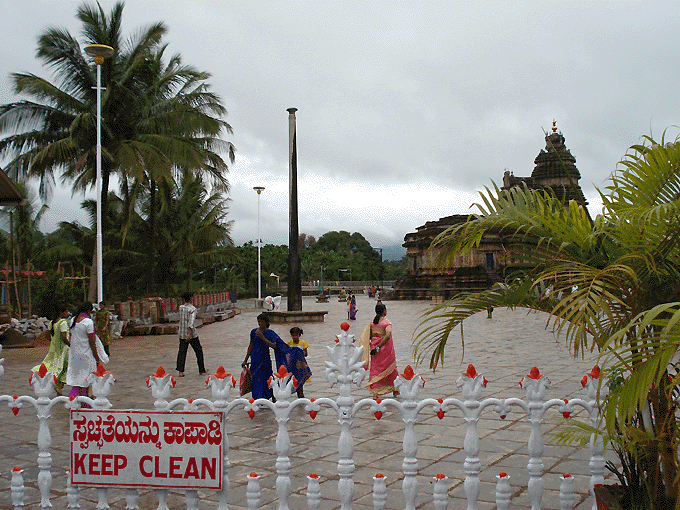
Courtyard between Vidyashankara and Sri Shankar Temples Vidyashankara Temple is considered to be the abode of the Sarada peetham, having been founded by Adi Shankaracharya. It shares a common courtyard with the Sharadamba Temple. The deities at Sharadamba Temple are also quite wonderful, with Venugopala and Srinivasa being made of rubies, and a Nandi, carved from a single large pearl.
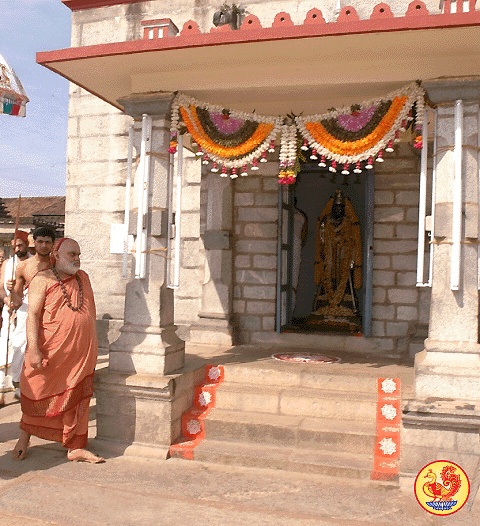
Sri Malayala Brahma Temple To the right of Sri Sharadamba Temple is the Malayala Brahma Temple, which is not associated with Lord Brahma, but rather with a legend about a brahmin scholar who, after learning the Vedas, would not share his knowledge with others. Because this went against his dharma, he was cursed to become a Brahma rakshas. Sometime thereafter, the Sage Vidyaranya, while on pilgrimage, stopped at this place. The Brahma rakshas begged the sage to free him from the curse, which he did, first making the rakshasa promise that he would stay as a caretaker of the Sharadamba matha. The name Sringeri comes from Rishyashringa-giri, a nearby hill that was once home to the hermitage of Rishi Vibhandaka and his son, Rishyashringa, whose pastimes are described in the Bala-Kanda of the Ramayana. Adi Shankaracarya is said to have selected this site for his matha because, while walking along the Tunga river, he saw a cobra with a raised hood, providing shelter from the hot sun for a frog about to spawn. Because these natural enemies had controlled their instincts, the Shankaracary chose to stay here for 12 years.
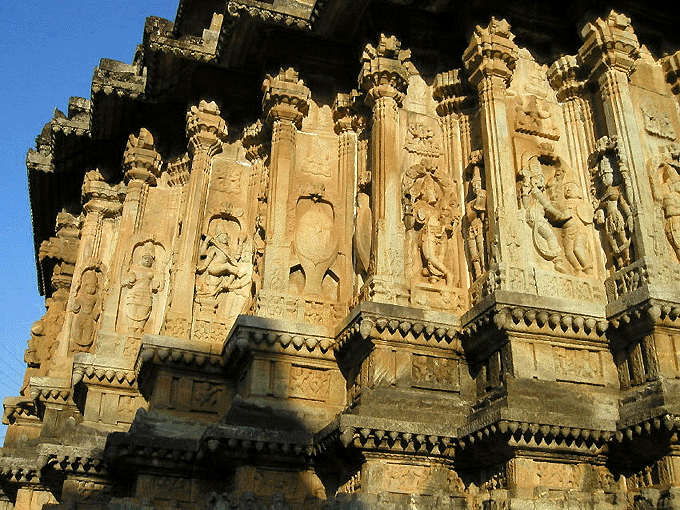
Vidyashankara Temple exterior carvings There is also a deity of Lord Brahma outside the main shrine of Sri Sharada Devi. Strangely enough, there is a nail in the deity's forehead, said to have been put there because Brahmadeva had a habit of wandering away. Vidyatirtha Rathotsava is celebrated on a grand scale during Kartika Shukla paksha. The festival runs for seven days, from Tritiya to Navami.
| |
